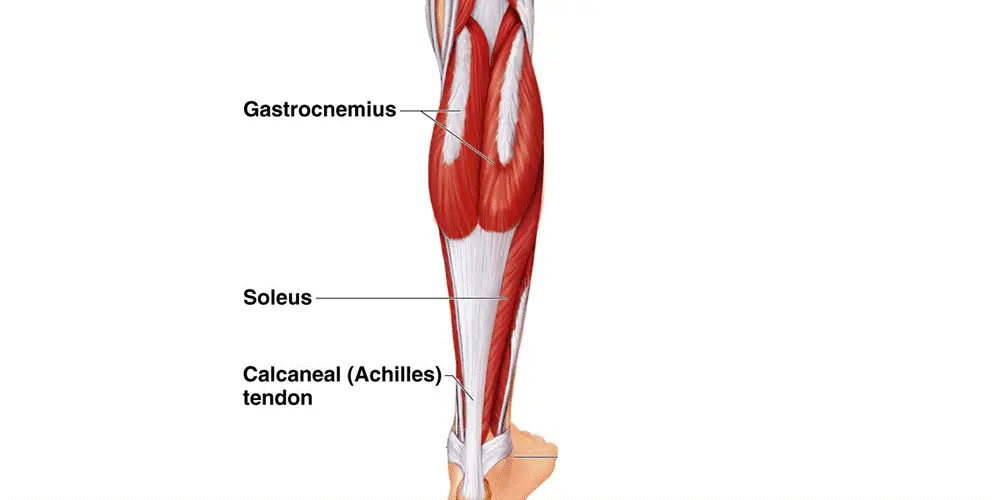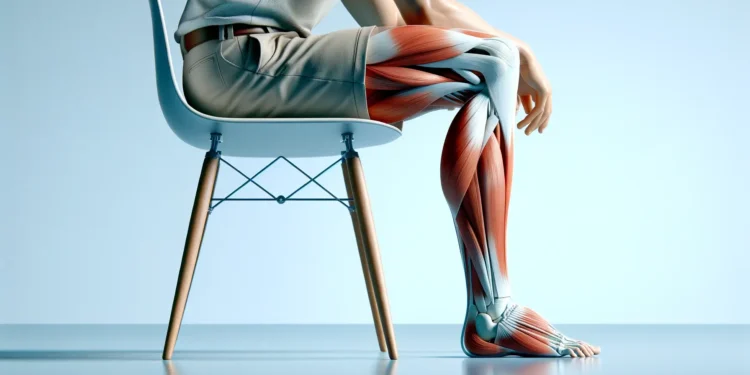Did you know that the soleus muscle, which accounts for only 1% of your body weight, has the power to significantly improve your metabolic health? It’s true! Research conducted by Marc Hamilton from the University of Houston has discovered that activating the soleus muscle correctly can lead to remarkable benefits.
Key Takeaways:
- Activating the soleus muscle can improve metabolic health.
- Soleus push-ups elevate muscle metabolism for hours, even while sitting.
- The soleus muscle is crucial for lower leg strength and stability.
- Soleus push-ups specifically target the calf muscles, providing various benefits for overall health and fitness.
- Incorporating soleus push-ups into your workout routine can enhance endurance and lower leg performance.
Importance of Soleus Muscles in the Lower Legs
The lower legs consist of numerous muscles that work together to provide stability, balance, and strength during physical activity. Among these muscles, the soleus muscles play a vital role in supporting lower leg function.
Despite their small size, the activation and training of the soleus muscles are crucial for maintaining optimal lower leg strength and overall lower body function.
The soleus muscles are primarily responsible for plantar flexion, which is the action of pointing the toes downward. This movement is essential for activities such as walking, running, jumping, and even standing.
Without proper activation of the soleus muscles, individuals may experience difficulties in maintaining balance and stability, as well as a decrease in lower leg strength.
By incorporating targeted exercises that activate and strengthen the soleus muscles into a fitness routine, individuals can experience numerous benefits. These exercises focus on lower leg strength training and soleus activation, helping to improve stability, balance, and overall lower leg strength.
Whether you’re an athlete looking to enhance performance or an individual seeking to improve lower body function, training the soleus muscles can significantly contribute to achieving your goals.
An effective exercise for targeting the soleus muscles is the soleus push-up. This exercise engages the soleus muscles by performing a push-up motion while standing on the edge of a step, with the heel hanging off.
As the heel is lowered towards the ground, the calf muscles are stretched, and then the individual pushes themselves up onto their toes, activating the soleus muscles. This exercise is particularly beneficial for activating the soleus muscles and improving lower leg strength and endurance.
Incorporating soleus muscle exercises into a regular fitness routine can have a positive impact on overall lower leg function, reducing the risk of injuries and improving performance in various physical activities.
Whether you’re a runner, a weightlifter, or simply someone looking to improve lower leg strength, focusing on soleus training can help you achieve your fitness goals and enhance your overall lower body function.
Take a look at the table below for a summary of benefits associated with soleus muscle training:
| Benefits of Soleus Training |
|---|
| Improved stability and balance |
| Enhanced lower leg strength |
| Reduced risk of lower leg injuries |
| Improved performance in physical activities |
By focusing on lower leg strength training and soleus activation, individuals can reap the benefits of soleus training and improve their overall lower body function. Incorporating targeted exercises like the soleus push-up into a regular fitness routine can make a significant difference in stability, balance, and lower leg strength.
Understanding Soleus Push-Ups and Their Benefits
Soleus push-ups are an effective variation of the traditional push-up exercise that specifically target the soleus muscles in the calves. Unlike regular push-ups that primarily focus on the chest and triceps, soleus push-ups engage the lower leg muscles, particularly the soleus muscles, providing a unique and targeted workout.
To perform soleus push-ups, start by standing on the edge of a step with your heel hanging off. Keep the ball of your foot on the step as you lower your heel towards the ground. This motion stretches the calf muscles, preparing them for activation.
Then, push yourself up onto your toes, activating the soleus muscles in a controlled motion. This exercise not only strengthens the calf muscles but also improves balance and enhances overall lower leg function.

By incorporating soleus push-ups into your workout routine, you can effectively target and strengthen your calf muscles, which play a crucial role in lower leg stability and mobility. This exercise can be particularly beneficial for athletes, dancers, and individuals seeking to improve their lower leg strength and performance.
“Soleus push-ups provide a targeted workout for the soleus muscles, which are often neglected in traditional exercise routines. By activating and strengthening these muscles, individuals can improve their balance, stability, and overall lower leg function.” – Dr. Sarah Johnson, Sports Medicine Expert
In addition to their muscle-strengthening benefits, soleus push-ups also help improve overall lower leg function. By focusing on the soleus muscles, individuals can enhance their control, stability, and movement in activities that require lower leg strength, such as running, jumping, and dancing.
Push-Up Variations for Well-Rounded Lower Leg Workout
Incorporating different push-up variations can further diversify and enhance your lower leg workout routine. Here are a few push-up variations that target various muscle groups in the lower legs:
- Single-Leg Push-Ups: By performing push-ups while balancing on one leg, you further engage the calf muscles and improve stability.
- Wide Stance Push-Ups: Placing your hands wider than shoulder-width apart during push-ups targets the outer calf muscles, helping to develop a well-rounded lower leg.
- Decline Push-Ups: Performing push-ups with your feet elevated on a stable surface, such as a bench, places greater emphasis on the calf muscles.
By incorporating these push-up variations into your workout routine, you can challenge and strengthen different muscles in the lower legs, achieving a comprehensive and well-rounded lower leg workout.
| Push-Up Variation | Muscles Targeted |
|---|---|
| Single-Leg Push-Ups | Calf muscles, quadriceps, glutes, core |
| Wide Stance Push-Ups | Soleus, gastrocnemius, tibialis anterior |
| Decline Push-Ups | Soleus, gastrocnemius, triceps, chest |
By incorporating soleus push-ups and other push-up variations into your fitness routine, you can effectively target and strengthen the muscles in your lower legs. These exercises not only improve muscle strength but also enhance balance and overall lower leg function, helping you achieve optimal performance in various physical activities.
Research on the Benefits of Soleus Push-Ups
Research conducted by Marc Hamilton and his team has demonstrated the significant benefits of soleus push-ups. According to their findings, soleus push-ups can sustain an elevated oxidative metabolism in the soleus muscles for extended periods.
This sustained elevation in metabolism improves the regulation of blood glucose and can be more effective than other popular methods such as exercise, weight loss, and intermittent fasting.
Additionally, muscle biopsies revealed that the soleus muscles rely less on glycogen and instead use other fuel sources such as blood glucose and fats. This unique metabolic process allows the soleus muscles to work for longer periods without fatigue, enhancing endurance and overall lower leg performance.
The findings of this research highlight the importance of soleus muscle exercises and the health benefits they provide. By incorporating soleus push-ups into a fitness routine, individuals can experience improved metabolic health, enhanced endurance, and increased lower leg strength.

The Role of Soleus Muscles in Metabolic Health
The soleus muscles, located in the calf, are essential for stabilizing the ankle joint and contributing to movement. These muscles primarily consist of slow-twitch muscle fibers, which are known for their endurance capacity.
By targeting and activating the soleus muscles through exercises like soleus push-ups, individuals can promote an increase in oxidative metabolism within these muscles. This metabolic response is associated with numerous health benefits, particularly concerning blood glucose regulation and endurance.
Comparing Soleus Push-Ups to Other Exercise Methods
Soleus push-ups offer a unique advantage over traditional exercise methods when it comes to metabolic health. While exercises like weight lifting and cardiovascular activities can promote general fitness and muscle development, soleus push-ups specifically target the soleus muscles, creating a concentrated effect.
This focused activation leads to a sustained elevation in oxidative metabolism in the soleus muscles, resulting in improved blood glucose regulation and enhanced endurance.
Benefits of Soleus Push-Ups for Lower Leg Performance
In addition to their metabolic benefits, soleus push-ups can significantly improve lower leg performance. The activation and strengthening of the soleus muscles contribute to better stability, balance, and lower leg strength.
These benefits are particularly beneficial for athletes participating in sports that require explosive lower leg movements, such as running, jumping, and dancing.
| BENEFITS OF SOLEUS PUSH-UPS |
|---|
| Elevated oxidative metabolism in soleus muscles |
| Improved blood glucose regulation |
| Enhanced endurance |
| Increased lower leg strength |
| Better stability and balance |
By incorporating soleus push-ups into a comprehensive fitness routine, individuals can maximize the benefits for lower leg performance and metabolic health. These exercises can be performed at home or at the gym, making them accessible and versatile for individuals of all fitness levels.
Incorporating Soleus Push-Ups into Fitness Routines
To enhance lower leg strength, stability, and endurance, individuals can incorporate soleus push-ups into their regular fitness routines. This simple yet effective exercise specifically targets the soleus muscles in the calves, providing a comprehensive calf muscle workout.
Here’s a step-by-step guide on how to perform soleus push-ups:
- Stand on the edge of a step, ensuring that the heel hangs off.
- Keep the ball of your foot on the step while lowering the heel towards the ground.
- Feel the stretch in your calf muscles.
- Push yourself up onto your toes, effectively activating the soleus muscles.
- Repeat this motion to specifically target and strengthen the soleus muscles.
By adding soleus push-ups to your workout routine, you can enhance muscular strength, stability, and endurance in the lower legs. This exercise complements other soleus muscle exercises and calf muscle workouts, providing a well-rounded approach to lower leg fitness.
Remember to consult with a fitness professional or trainer to ensure proper form and technique when performing soleus push-ups. Gradually increase the intensity and number of repetitions as your strength and endurance improve.
For visual reference, here is an image demonstrating the technique:
Conclusion
In conclusion, incorporating soleus push-ups into your fitness routine can provide numerous health benefits for your lower legs and overall metabolic health. By actively engaging and training the soleus muscles, you can enhance calf strength, stability, and endurance.
Research has shown that soleus push-ups can sustain an elevated oxidative metabolism in the soleus muscles, leading to improved regulation of blood glucose.
By adding soleus push-ups to your workout routine, you can improve lower leg function, reduce the risk of injuries, and enhance overall physical performance.
Whether you’re an athlete aiming to optimize your performance or an individual looking to strengthen your lower legs, soleus push-ups are a valuable addition to any calf muscle workout routine.
Start reaping the benefits of soleus training and incorporate soleus push-ups into your fitness regimen. You’ll not only develop stronger and more stable calf muscles but also improve your metabolic health and overall well-being.
FAQ
What are the health benefits of soleus push-ups?
Soleus push-ups offer numerous benefits, including improved metabolic health, enhanced calf muscle strength and endurance, better balance and stability, and reduced risk of lower leg injuries.
How do soleus push-ups activate the soleus muscles?
Soleus push-ups specifically target the soleus muscles in the calves. By standing on the edge of a step with the heel hanging off and lowering the heel towards the ground while keeping the ball of the foot on the step, the calf muscles are stretched. Pushing up onto the toes completes the motion, effectively activating the soleus muscles.
Are soleus push-ups suitable for everyone?
Soleus push-ups can be adapted to different fitness levels. Beginners can start with modified versions or fewer repetitions and gradually increase the intensity as they build strength and endurance. It is always advisable to consult with a healthcare professional before starting any new exercise routine.
Can soleus push-ups improve metabolic health?
Yes, research has shown that soleus push-ups can sustain an elevated oxidative metabolism in the soleus muscles for extended periods. This can enhance the regulation of blood glucose and have significant benefits for overall metabolic health.
How often should I incorporate soleus push-ups into my fitness routine?
The frequency of soleus push-ups can vary depending on individual fitness goals and capabilities. It is generally recommended to start with 2-3 sessions per week and gradually increase as tolerated. It is essential to allow proper rest and recovery between sessions to avoid overtraining and potential injury.
Can soleus push-ups help improve lower leg performance for athletes?
Yes, incorporating soleus push-ups into a workout routine can enhance lower leg strength, endurance, and stability, which are essential for various physical activities. Athletes can benefit from the improved performance and reduced risk of lower leg injuries that soleus push-ups offer.



























